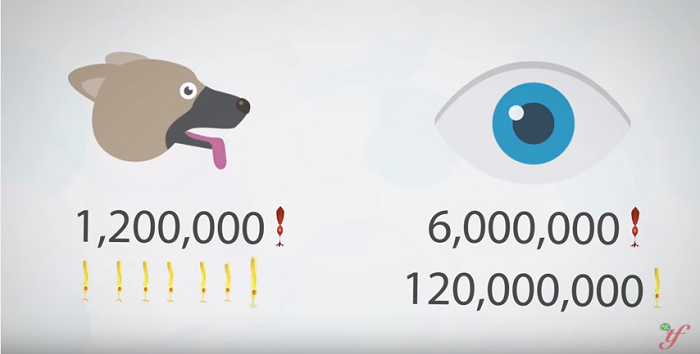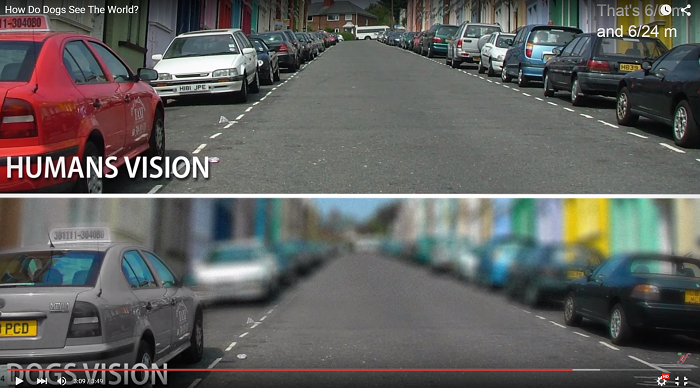For many years, it was widely believed that dogs were completely colorblind and could only see the world in shades of black and white. This misconception endured for decades, but advancements in scientific research have since debunked this myth. Today, we understand that dogs do indeed see colors, but their perception of color is quite different from that of humans. Knowing how dogs see the world around them can help us provide a more enriching and supportive environment for our canine companions, enhancing their quality of life and our relationship with them.
The Science Behind Dog Vision
The ability to see color and light depends on the presence of cones, rods, and ganglion cells in the eyes. Cones are responsible for color vision, while rods handle low-light and peripheral vision.
Human vs. Dog Cone and Rod Cells
Humans have a high number of cones compared to dogs. Our eyes contain three types of cones, allowing us to perceive a wide range of colors. In contrast, dogs have fewer cones but a higher number of rods. Here’s a closer look at the differences:
- Cones: Humans have approximately 6 million cones, giving us the ability to see a broad spectrum of colors. Dogs have fewer cones, which means they see fewer colors.
- Rods: Dogs have significantly more rods than humans, making them about five times more sensitive to light. This gives them superior night vision and motion detection capabilities.

The Fovea: Clarity of Vision
Humans also have a fovea, a small depression in the retina where visual acuity is highest. This allows us to see clear and detailed images. Dogs lack a fovea, which affects the sharpness of their vision.
Color Perception: Trichromatic vs. Dichromatic Vision
Humans are trichromatic, meaning we have three types of cones that detect blue, green, and red. This allows us to see around one million different shades and colors.
Dogs, on the other hand, are dichromatic. Their cones only detect blue and yellow, limiting their color perception to about 10,000 shades. Here’s a fun fact: This is why agility equipment is often designed with blue and yellow colors, making it easier for dogs to see and navigate.
What Colors Do Dogs See?
- Blue and Yellow: Dogs can see these colors clearly.
- Red and Green: Dogs cannot distinguish these colors. Red objects may appear dark brown or black, and green objects can look similar to gray or white.

This understanding is crucial when selecting toys and accessories for your dog. Opt for blue or yellow items, especially if you plan to use them outdoors. A red toy might be hard for your dog to find in green grass since both colors appear similar to them.
Field of Vision and Motion Detection
Dogs have a wider field of vision compared to humans. While our field of vision is about 190 degrees, dogs can see around 250 degrees, depending on the breed. This wide field of vision helps them detect movement from a greater range.
Dogs also excel in motion detection due to their higher number of rods and the presence of a tapetum lucidum, a reflective layer behind the retina. This layer acts like a mirror, reflecting light back through the retina and enhancing their ability to see in low-light conditions. This is why dogs’ eyes often appear to glow in the dark.

Night Vision Superiority
Thanks to their rod-dominated retinas, larger pupils, and tapetum lucidum, dogs have much better night vision than humans. This adaptation allows them to see in dim light conditions where humans would struggle.
Visual Acuity: Near vs. Far
While dogs have superior night vision and motion detection, their visual acuity is not as sharp as ours. Humans can see objects clearly from a greater distance. For example, something that a human can see clearly at 80 feet might only be visible to a dog from 20 feet away.
Comparing Visual Clarity
- Humans: Clearer vision at longer distances due to the fovea.
- Dogs: Clearer vision at shorter distances but superior night vision.
Understanding Dog Vision: Practical Implications
Knowing how dogs see the world can influence our choices in dog toys, accessories, and training equipment. For instance, selecting blue or yellow toys can make playtime more enjoyable for your dog. When training, using high-contrast colors can improve your dog’s performance and engagement.
Toy and Accessory Selection
- Toys: Choose blue or yellow toys for better visibility.
- Beds and Bowls: Consider the color contrast to make these items more distinguishable for your dog.
- Training Equipment: Use blue/yellow color schemes to enhance your dog’s ability to see and interact with the equipment.
The Joy of Understanding Your Dog’s Vision
It’s fascinating to understand the colors your dog can and cannot see. This knowledge not only enhances the bond between you and your furry friend but also improves their quality of life. Imagine the joy your dog will experience when they can easily spot their toys, even in tall grass or dim light.
A Clearer View: Seeing the World Through Your Dog’s Eyes
Understanding that dogs are not colorblind but see the world differently than humans is crucial. They have dichromatic vision, meaning they see primarily blue and yellow, and their superior night vision and motion detection abilities set them apart from us. This knowledge can help us make better choices in selecting toys, accessories, and training tools for our canine companions.
So next time you’re shopping for your dog, remember their unique vision capabilities. Choose colors they can see, and consider their superior night vision and motion detection. It might just make their world a little brighter and more fun.
Share your thoughts and experiences in the comments! Have you noticed your dog struggling with certain colored toys? What changes will you make now that you know more about their vision? Let us know!

